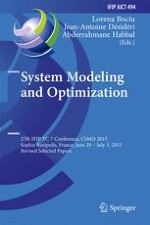This book is a collection of thoroughly refereed papers presented at the 27th IFIP TC 7 Conference on System Modeling and Optimization, held in Sophia Antipolis, France, in June/July 2015.
The 48 revised papers were carefully reviewed and selected from numerous submissions. They cover the latest progress in their respective areas and encompass broad aspects of system modeling and optimiza-tion, such as modeling and analysis of systems governed by Partial Differential Equations (PDEs) or Ordinary Differential Equations (ODEs), control of PDEs/ODEs, nonlinear optimization, stochastic optimization, multi-objective optimization, combinatorial optimization, industrial applications, and numericsof PDEs.
